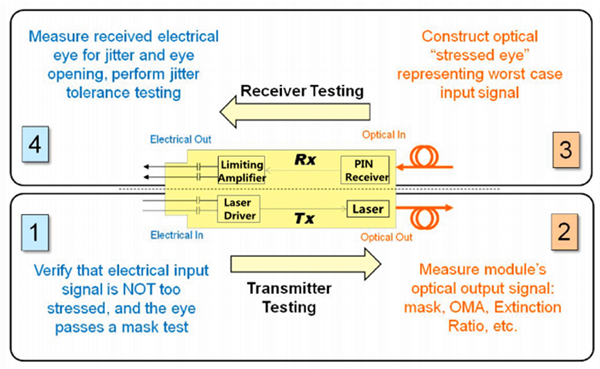How to Test a XFP Transceiver?
2017-09-02
After installing the XFP transceiver, testing its performance is an essential step. How to test it? You may get the answer on this article.
There are four steps in testing an XFP transceiver (As shown in the following picture), which mainly includes the transmitter testing and receiver testing.
Transmitter Testing
There are two steps to test a transmitter:

1. The input signal used to test the transmitter must be good enough. And also need to confirm the quality of electrical measurement by jitter measurement and eye diagram measurement. Eye diagram measurements are common ways to check transmitter output waveform, because eye diagram contains abundant information, can reflect the overall performance of the transmitter.
2. The optical output of the transmitter must be tested using several optical quality metrics such as eye diagram test, OMA (optical modulation amplitude), and Extinction Ratio.
Receiver Testing
To test a receiver, there are also two steps:
3. Unlike testing the transmitter, the quality of the optical signal must be poor enough when testing the receiver.
4、Finally, the electronic output signal of the receiver needs to be tested. There are three main types:
※ Eye diagram test, which ensures the “eyes” of eye diagram are open. The eye diagram test is usually achieved by BER(bit error ratio) depth
※ Jitter Test, testing different types of jitter
※ Jitter tracking and tolerance, testing the tracking of jitter in the internal clock recovery circuit
All in all, testing a optical transceiver is a complex job, but it is an indispensable step to ensure its performance. Fiberland provides all kinds of transceivers, which can be compatible with many brands, such as Cisco, HUAWEI, ZTE, Allied Telesis, HP, Brocade, DELL, Juniper. In Fiberland, each transceiver will be tested to ensure our customers to receive the products with superior quality.
XFP module,XFP transceiver,bidi sfp,SFP+ module,SFP+ transceiver Which is good? First choice Fiberland!Thanks for your concern, to learn more about Fiberland, please enter Fiberland website: http://www.fiberlandtec.com/
There are four steps in testing an XFP transceiver (As shown in the following picture), which mainly includes the transmitter testing and receiver testing.
Transmitter Testing
There are two steps to test a transmitter:

1. The input signal used to test the transmitter must be good enough. And also need to confirm the quality of electrical measurement by jitter measurement and eye diagram measurement. Eye diagram measurements are common ways to check transmitter output waveform, because eye diagram contains abundant information, can reflect the overall performance of the transmitter.
2. The optical output of the transmitter must be tested using several optical quality metrics such as eye diagram test, OMA (optical modulation amplitude), and Extinction Ratio.
Receiver Testing
To test a receiver, there are also two steps:
3. Unlike testing the transmitter, the quality of the optical signal must be poor enough when testing the receiver.
4、Finally, the electronic output signal of the receiver needs to be tested. There are three main types:
※ Eye diagram test, which ensures the “eyes” of eye diagram are open. The eye diagram test is usually achieved by BER(bit error ratio) depth
※ Jitter Test, testing different types of jitter
※ Jitter tracking and tolerance, testing the tracking of jitter in the internal clock recovery circuit
All in all, testing a optical transceiver is a complex job, but it is an indispensable step to ensure its performance. Fiberland provides all kinds of transceivers, which can be compatible with many brands, such as Cisco, HUAWEI, ZTE, Allied Telesis, HP, Brocade, DELL, Juniper. In Fiberland, each transceiver will be tested to ensure our customers to receive the products with superior quality.
XFP module,XFP transceiver,bidi sfp,SFP+ module,SFP+ transceiver Which is good? First choice Fiberland!Thanks for your concern, to learn more about Fiberland, please enter Fiberland website: http://www.fiberlandtec.com/
RECENT BLOG POST
-
012019-10With the continuous development of 5G communication technology, 100G modules are gradually becoming popular. We know that there are many kinds of packages for 100G optical modules. From 2000 to now, the optical module package types have been rapidly developed. Its main package types are: GBIC, SFP, XENPAK, SNAP12, X2, XFP, SFP+, QSFP/QSFP+, CFP, CXP. In the fast-developing network era, some 100G optical modules avoid the risk of being eliminated, and upgraded and revised with the wave of the Internet, such as 100G CFP optical modules.
-
012019-101. What is the CWDM SFP? The CWDM optical module is an optical module using CWDM technology to implement the connection between the existing network device and the CWDM multiplexer/demultiplexer. When used with a CWDM multiplexer/demultiplexer, CWDM optical modules can increase network capacity by transmitting multiple data channels with separate optical wavelengths (1270 nm to 1610 nm) on the same single fiber.
-
012019-10AOC is the abbreviation of Active Optical Cables, which is called Active Optical Cables in Chinese. AOC active optical is to encapsulate two optical modules and cable together. Because the medium of transmission in the middle is optical cable, AOC optical module, which contains laser devices, has a higher price for DAC. However, its optical aperture is not exposed, it has high reliability, and its working distance can be customized for a long distance of less than 100 meters.
-
012019-10Dense Wavelength Division Multiplexing (DWDM) technology is capable of transmitting data in an optical fiber using bit wavelength parallel transmission or string line transmission using the wavelength of the laser.It is widely used in different fields of communication networks, including long-distance backbone networks, metropolitan area networks (MANs), residential access networks, and local area networks (LANs).The DWDM optical module is the optical module that uses this technology, so the DWDM optical module has high bandwidth and long-distance transmission characteristics.












